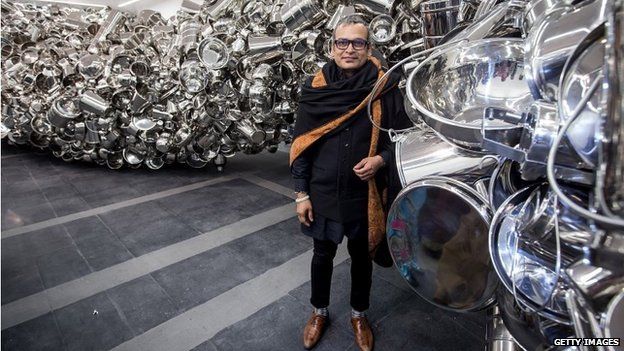The stainless shine of Indian artist Subodh Gupta's art
- Published

A show by a top Indian artist, Subodh Gupta, has opened in Delhi. It draws together the maverick artist's varied body of work, including painting, sculpture, video and installation. Indrajit Hazra reports on the largest show ever dedicated to a contemporary artist at India's leading gallery.
A giant shape hovers like a gliding whale in one of the large gallery spaces at the National Gallery of Modern Art (NGMA) in Delhi.
It is a giant wooden longboat tilted with most of its imposing mass hanging in the air.
Eleven revolving ceiling fans, turned upside down to look like propellers, seem to be lifting the boat crammed with dull, moulded metal pots and pans.
It is futuristic in its anti-gravitational longings, and yet moored in the wood and metal of the present and past.
Visual treat
The installation - All In The Same Boat - is only one of the startlingly beautiful works that make Everything Is Inside, Subodh Gupta's show, such a visual and spatial treat.
In his works, 50-year-old Gupta tips his hat to Marcel Duchamp and the Dadaists, the early 20th century masters who subverted art by turning ordinary items into art.
He also pays tribute to the everyday objects of his youth - mostly the trademark stainless steel thalis (plates) and dabbas (containers) in which most middle-class families served and ate their meals.
Gupta's obsession with the everyday and the mundane is rooted in his observations during his formative years in the eastern state of Bihar.
In the late 1960s, growing up in Khagaul town, it was his interest in theatre that drew him to the creative arts.
This flair for drama, that he first displayed in Patna's Art College, is what distinguishes Gupta and got him noticed by established artist MF Husain.
Gupta says he rarely uses people in his installations.
"I've always been surrounded by people. But I play with objects. Very few people appear in my works," he says.
"I'm looking at surroundings. And I'm definitely looking at objects in a different way."
A top half of a sliced yellow-black Ambassador taxi, with the luggage of bronze blocks loaded on its rooftop, is the title piece of the exhibition.
Created in 2004, what looks like a mutilated car-sculpture would be, to Gupta and most Indians, a freeze-frame of a familiar sight - a taxi half-submerged on a flooded monsoon road.
Love for steel
Gupta loves steel and the metal has been a constant in his work as an artist - whether it is Faith Matters, a sushi conveyer belt carrying and moving an array of containers along a large table echoing an airport immigration line, or Thosa Pani (Solid Water), the frozen cascade of welded utensils made to tumble through a room and down the stairs like a tidal force.
Writer Amitava Kumar, in his short biography of Patna, A Matter of Rats, describes the origins of Gupta's love affair with the alloy.
The artists's youngest sister discovered in the early 1970s how stainless steel utensil-manufacturing companies had come up with a scheme in which one could get two new steel plates in exchange for three plates of other metals.
"This meant that the [Gupta] family was no longer eating from the dull brass plates they had used till then," writes Kumar.
"Twenty years later, the page turned. Gupta was in his kitchen, cooking, and thinking that his art lacked lustre. That's when the stainless steel plates of his childhood swam into view."
Even as he has produced commissioned art works for international brands like Chanel and Absolut, and his untitled installation of steel pots sold for a record $1.2m (£726,440) in a 2008 Christie's auction, Gupta has rarely strayed from forms and motifs familiar to Indians.
Despite that, his art has been acclaimed globally and he is compared to international contemporary artists such as Damien Hirst, Jeff Koons and Ai Weiwei.
The most stunning work from Everything Is Inside, however, stands outside the gallery - the winter sun bounces off a banyan tree made of polished, hyper-reflective steel on the lawn and the installation, with its branches curving into roots with clusters of steel utensils swaying in the breeze, has a distinct mythological quality to it.
For Gupta, the tree is its title: Dada, the Hindi word for grandfather, the patriarch under whose protection a family thrives and in whom one sees one's own reflection.
"When families and people come here and take photos on their phones under the tree, it gives me real pleasure," says Gupta.
The strange thing is that Gupta's shimmering tree out in the lawn makes us see the real trees with their green leaves and brown trunks in a completely new way.
Which is exactly what Subodh Gupta has been doing for the last 25 years.
Indrajit Hazra is a writer and journalist. His latest book is Grand Delusions: A Short Biography of Kolkata
- Published24 August 2009